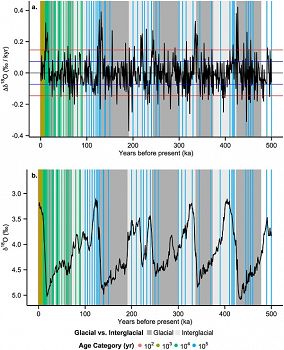Shepard et at., 2018
Signatures of Obliquity and Eccentricity in Soil Chronosequences
Shepard C., Pelletier J.D., Schaap M.G., Rasmussen C. (2018)
Geophysical Research Letters 45(20): 11147–11153
-
Catalina-Jemez, GRAD STUDENT
-
Catalina-Jemez, INVESTIGATOR
-
Catalina-Jemez, INVESTIGATOR
Plain English Summary
Over the past 2.6 million years, the Earth's climate has cycled at regular intervals in concert with orbital variations. Climate variations have driven changes in the rates of erosion and deposition of new sediment, but detection of these orbitally driven climate cycles has remained elusive in soil systems. We demonstrated that soils were preserved to the present at the same intervals as known orbital climate cycles using a meta‐analysis of soil chronosequences. We further tied dominant periods of soil formation to periods of relatively low rates of past climate change or periods of relatively stable, unchanging climate that enable soil formation. Our results provide a better understanding of how climate change impacts landscapes, which could greatly enhance our understanding of the impact of future climate change on soil resources and new insights into past environmental changes.
Abstract
Time of soil formation related to the LR04 Stack δ18O record (Lisiecki & Raymo, 2005). Soil ages preferentially grouped around relatively stable interglacial stages. The colored vertical lines represent the age of each soil in the chronosequence database (Shepard et al., 2017) categorized into order of magnitude categories, from 102 to 105 years; the dark gray bars represent glacial isotope stages, and the lighter gray bars represent interglacial isotope stages. (a) Rate of change of δ18O record from 0 to 500 ka (Δδ18O); the black horizontal line represents the mean rate, the blue horizontal line represents ±1σ of Δδ18O, and the red horizontal line represents ±2σ of Δδ18O. (b) LR04 Stack δ18O record from 0 to 500 ka.
Periodic shifts in Earth's orbit alter incoming solar radiation and drive Quaternary climate cycles. However, unambiguous detection of these orbitally driven climatic changes in records of terrestrial sedimentation and pedogenesis remains poorly defined, limiting our understanding of climate change‐landscape feedbacks, impairing our interpretation of terrestrial paleoclimate proxies, and limiting linkages among pedogenesis, sedimentation, and paleoclimatic change. Using a meta‐analysis, we show that Quaternary soil ages preserved in the modern record have periodicities of 41 and 98 kyr, consistent with orbital cycles. Further, soil ages predominantly date to periods of low rates of climatic change following rapid climate shifts associated with glacial‐to‐interglacial transitions. Soil age appears linked to orbital cycles via climate‐modulated sediment deposition, which may largely constrain soil formation to distinct climate periods. These data demonstrate a record of widespread orbital cyclicity in sediment deposition and subsequent pedogenesis, providing a key insight into soil‐landscape evolution and terrestrial paleo‐environment changes.
Citation
Shepard C., Pelletier J.D., Schaap M.G., Rasmussen C. (2018): Signatures of Obliquity and Eccentricity in Soil Chronosequences. Geophysical Research Letters 45(20): 11147–11153. DOI: 10.1029/2018GL078583
 This Paper/Book acknowledges NSF CZO grant support.
This Paper/Book acknowledges NSF CZO grant support.
Explore Further




